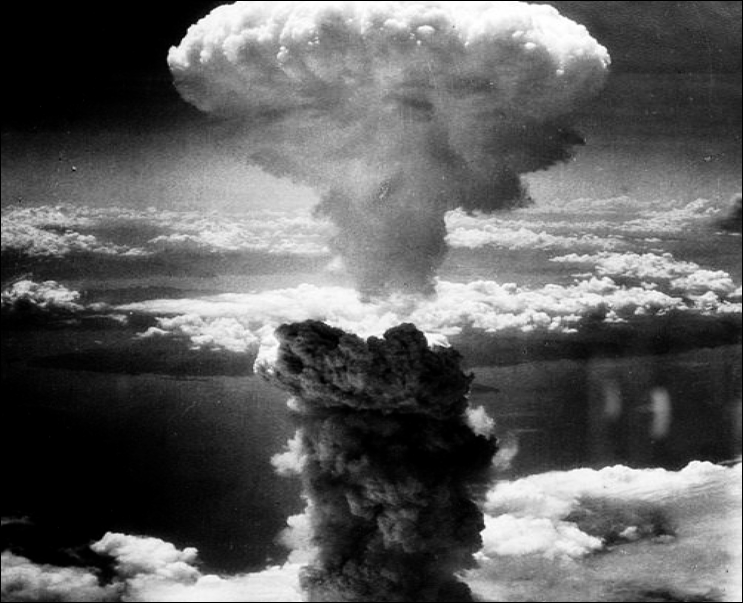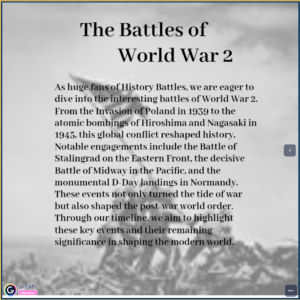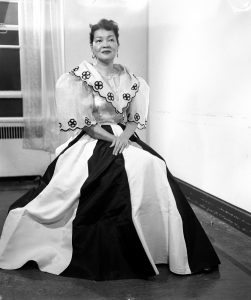Winner of the Spring 2017 StMU History Media Awards for
Best Article in the Category of “World History”
“We knew the world would not be the same. A few people laughed, a few people cried, most people were silent. I remembered the line from the Hindu scripture the Bhagavad Gita. Vishnu is trying to persuade the prince that he should do his duty and to impress him takes on his multiarmed form and says, ‘Now, I am become Death, the destroyer of worlds.’ I suppose we all thought that one way or another.”1
- J. Robert Oppenheimer, The Decision to Drop the Bomb

Throughout the history of human warfare, conflict has pushed humans to innovate–to build ever larger and deadlier weapons, each more lethal than the last. However, it was not until World War II and the invention of the atomic bomb that humanity has been able to kill on such a massive and efficient scale. Case in point, in the final days of World War II, the United States carried out one of the most chilling instances of mass murder in the history of humanity: the bombing of the Japanese cities of Hiroshima and Nagasaki. These attacks ultimately killed an estimated 294,000 people, the majority of whom were noncombatants.2 In comparison, the Japanese attack on Pearl Harbor killed just 2,408 American citizens, although this is largely due to the focused Japanese attack on military targets, namely the Pacific fleet and U.S. airfields.3 To give a more modern frame of comparison, the terrorist attacks against the World Trade Center and Pentagon, considered to be by far the worst terrorist attacks against the United States, claimed the lives of 2,974 American citizens.4
In the spring of 1945, World War II was entering its final stages. The Allies had already achieved victory in Europe with Germany’s surrender on May 7th, but the conflict on the Pacific front was still going strong. In the years leading up to the two World Wars, Japan’s victories against two larger countries–China in the Sino-Japanese War (1894–1895) and Russia in the Russo-Japanese War (1904–1905)–combined with other factors, forged a strong sense of Japanese nationalism, militarism, and cultural superiority. This fervent nationalism, integrated with the Japanese warrior ethic known as bushido, made the prospect of a Japanese surrender unlikely, even as the Allies began to position for an invasion of the Japanese mainland.5

Concurrently, since as early as 1942, President Franklin Delano Roosevelt had been secretly sponsoring and funding The Manhattan Project, the code name used for the $2 billion U.S. effort to develop a nuclear weapon before the Germans. A team of top physicists led by Dr. Julius Robert Oppenheimer were assigned to this project, a task so secret that not even individuals as important as then Vice President Harry S. Truman was aware of it. Shortly after Roosevelt’s untimely death and Truman’s subsequent inauguration to the presidency in April 1945, he was informed that the Manhattan Project was approaching success–that a nuclear weapon would be feasible in just four short months.6
Faced with the prospect of a costly and deadly invasion of Japan, Truman and his advisors were faced with a difficult choice: utilize this new atomic weapon or try to defeat Japan through conventional means. In late July, the United States issued the Postdam Declaration, a statement which gave Japan the choice between unconditional surrender or total annihilation. When this declaration went ignored, President Truman authorized the use of the atomic bomb.7

On the morning of August 6, 1945, Colonel Paul Tibbets piloted the Enola Gay over the city of Hiroshima, where his crew dropped an atomic bomb code-named “Little Boy.” Upwards of 70,000 people died instantly in the blast. Additionally, 48,000 buildings were destroyed and another 22,000 were damaged, leaving only 6,000 buildings untouched. Three days later, on August 9th, a second bomb was dropped onto Nagasaki, killing another 36,000 people. In total, an estimated 295,000 were killed in the blasts or from complications from the resulting nuclear fallout.8
Emperor Hirohito ordered the surrender of Japan on August 10, 1945. On August 15th, radios across Japan broadcasted Hirohito’s words as he read the declaration of surrender to the Japanese people, thus ending World War II. The bombs’ effectiveness in forcing the Japanese to surrender is still subject of popular debate among historians to this day, given that the Russian invasion of Japan-controlled Manchuria occurred at the same time of Nagasaki, both of which likely impacted Japan’s will to continue fighting.9 Even so, while the political and military effects of these blasts may be debated, none can contest their tragedy and devastation.

- Jason Pontin, “Oppenheimer’s Ghost,” MIT Technology Review, October 15, 2007. https://www.technologyreview.com/s/408835/oppenheimers-ghost/. ↵
- Dennis W. Cheek, “Hiroshima and Nagasaki,” in Encyclopedia of Science, Technology, and Ethics, edited by Carl Mitcham, Vol. 2, Detroit: Macmillan Reference USA, 2005. Gale Virtual Reference Library (accessed February 6, 2017), 923. ↵
- Sonia Benson, Daniel E. Brannen, Jr., and Rebecca Valentine, “Pearl Harbor Attack,” in UXL Encyclopedia of U.S. History, Vol. 6, Detroit: UXL, 2009. Gale Virtual Reference Library (accessed February 6, 2017), 1208. ↵
- Stefan M. Brooks, “September 11 Attacks,” in The Encyclopedia of Middle East Wars: The United States in the Persian Gulf, Afghanistan, and Iraq Conflicts, edited by Spencer C. Tucker, Vol. 3, Santa Barbara, CA: ABC-CLIO, 2010. Gale Virtual Reference Library (accessed February 6, 2017), 1096. ↵
- “The United States Drops the Atomic Bomb on Hiroshima and Nagasaki,” in Global Events: Milestone Events Throughout History, edited by Jennifer Stock, Vol. 2, Asia and Oceania, Farmington Hills, MI: Gale, 2014. Gale Virtual Reference Library (accessed February 5, 2017), 361. ↵
- “An Overview of the Atomic Bombings of Hiroshima and Nagasaki,” in The Atomic Bombings of Hiroshima and Nagasaki, edited by Sylvia Engdahl, Perspectives on Modern World History, Detroit: Greenhaven Press, 2011. Gale Virtual Reference Library (accessed February 6, 2017), 13-14. ↵
- “An Overview of the Atomic Bombings of Hiroshima and Nagasaki,” in The Atomic Bombings of Hiroshima and Nagasaki, edited by Sylvia Engdahl, Perspectives on Modern World History, Detroit: Greenhaven Press, 2011. Gale Virtual Reference Library (accessed February 6, 2017), 14-15. ↵
- Dennis W. Cheek, “Hiroshima and Nagasaki,” in Encyclopedia of Science, Technology, and Ethics, edited by Carl Mitcham, Vol. 2, Detroit: Macmillan Reference USA, 2005. Gale Virtual Reference Library (accessed February 6, 2017), 923. ↵
- “The United States Drops the Atomic Bomb on Hiroshima and Nagasaki,” in Global Events: Milestone Events Throughout History, edited by Jennifer Stock, Vol. 2, Asia and Oceania, Farmington Hills, MI: Gale, 2014. Gale Virtual Reference Library (accessed February 5, 2017), 361. ↵



152 comments
Crystal Baeza
War is a topic that can many controversy. Some people think its necessary and some will think otherwise. I understand the first bombing on Hiroshima but the second bombing on Nagasaki was uncalled for. Many innocent people die on both sides of war, many are faced with aftermath injuries, and many are having to deal with the pain of lost loved ones. WWII was overall a mass destruction not only to Japan but other countries as well. Many lives a part of this catastrophy suffered in all ways possible. I just hope another bombing such at the ones in Japan never happen again.
Marina Castro
War is a topic that is always interesting to read about. It always creates an impact in the reader to learn more about how things were thought and developed into actions. However, when you put it in retrospective, it is very discouraging to know that these were people who died and suffered. The United States bombing Japan is just one of the many atrocities committed during WWII.
Christopher Hohman
Liked this article. Over the summer I read the book Rising Sun. It is very unfortunate that this happened, but I believe it was a necessary evil. The Japanese were never going to give up. They had too national spirit to do that. If the US had attempted a land invasion it would have cost maybe a million US lives and untold Japanese would have died also. as horrific as the the two atom bombs were they were necessary to bring a quicker end to the war.
Tyler Boyd
War is hell. It is death and destruction and that is unavoidable. It is also inevitable that civilian casualties will occur, the question is what number is too large? It is sometimes hard to think that we thought of ourselves as the moral superiors in WW2 but these tragedies that occurred can not be overlooked. Emperor Hirohito pleaded to his War Council to reconsider surrender after the Soviet invasion of Manchuria, which begs the question why did 294,000 people lose their lives if the Emperor was considering surrender? I think we view these events through hindsight which is always 20/20. However it has helped to prevent other nuclear attacks of this scale which is what we have to remember. History will repeat itself if we don’t remember previous mistakes and hopefully this will remain as an isolated historical event not to be repeated again.
Vanessa Tombo
The writer’s diction, structure of information, imagery, and tone were very well combined to make this article extremely impactful and most importantly educational. The bombing that occurred in Nagasaki and Hiroshima showed the power of fear. How it dwelled in the hearts of those involved in the decisions to drop the atomic bombs in Japan during World War 2. Many who died are left as the shadows plastered on walls, pavements, and sidewalks. To this day those who survived are still recovering from the horrific effects of the bomb: radiation sicknesses.
Yahaira Martinez
when i was in high school i saw this documentary over the survivors of Hiroshima and Nagasaki and what they remember. Throught the whole the documentary all i remember thinking is how could somebody do that to other human beings. this weapon not only changed the world and the level of mass destruction one could create but also changed the way humans see other humans. So many innocent people died just because of a new toy the country had developed.
Hanadi Sonouper
The atomic bombing in Hiroshima and Nagasaki is a historical event that will forever remain a mystery to the Japanese people. August 6, 1945 is the day that the United States of America used a colossal atomic bombing attacking against Japan in Hiroshima. The bomb was equivalent to twenty thousand tons of TNT. The attack flattened Hiroshima city and thousands of the Japanese people died in that horrible event. Before the Japanese could comprehend what happened, the US made another massive attack on Nagasaki. This is what is not known as proportional means, one bomb if not any would have send the message, but two was extremely unnecessary.
Michael Thomas
I found this article interesting because of how it details the bombings of Hiroshima and Nagasaki. The bombings of Hiroshima and Nagasaki was vengeance from the US after the attack on Pearl Harbor. Roosevelt must have felt that the Manhattan Project would be more than enough to avenge the fallen. Although the attack on Hiroshima and Nagasaki showed that the Manhattan Project was a success, the number of lives lost within the vicinity of bombs were significant.
Timothy ODekirk
This article was extremely interesting to me in many ways. I find World War Two extremely interesting due to the major brutality and damage that it inflicted on so many lives in so many countries. The bombing of Hiroshima and Nagasaki was a terrible example of this. The bombing of Hiroshima and Nagasaki, while effective for the United States, which pretty much wrapped up things for them against Japan during World War 2, was still devastating for the people living in those cities during that time. Many survivors in Hiroshima and Nagasaki developed radiation sickness due to the bombings. These were the negative effects that the atomic bombings affflcited on Hiroshima and Nagasaki during World War 2.
Grady Purcell
This weapon of mass destruction forever changed the world, when we dropped the bombs on Hiroshima and Nagasaki the world was so in shock to see such a weapon of the magnitude. I believe we used this lethal weapon in the wrong way because there are so many innocent people who died that day and the days after the bomb dropped because of radiation. We could have used this in a more tactical way rather than using it to show Japan the new weapon we had.